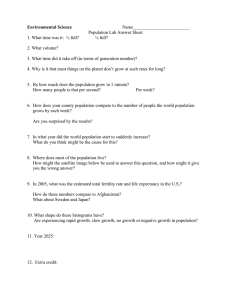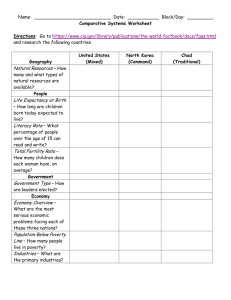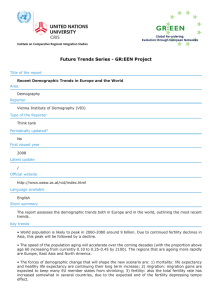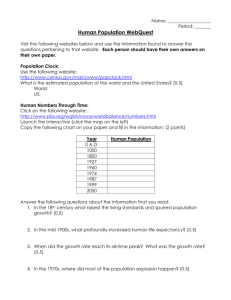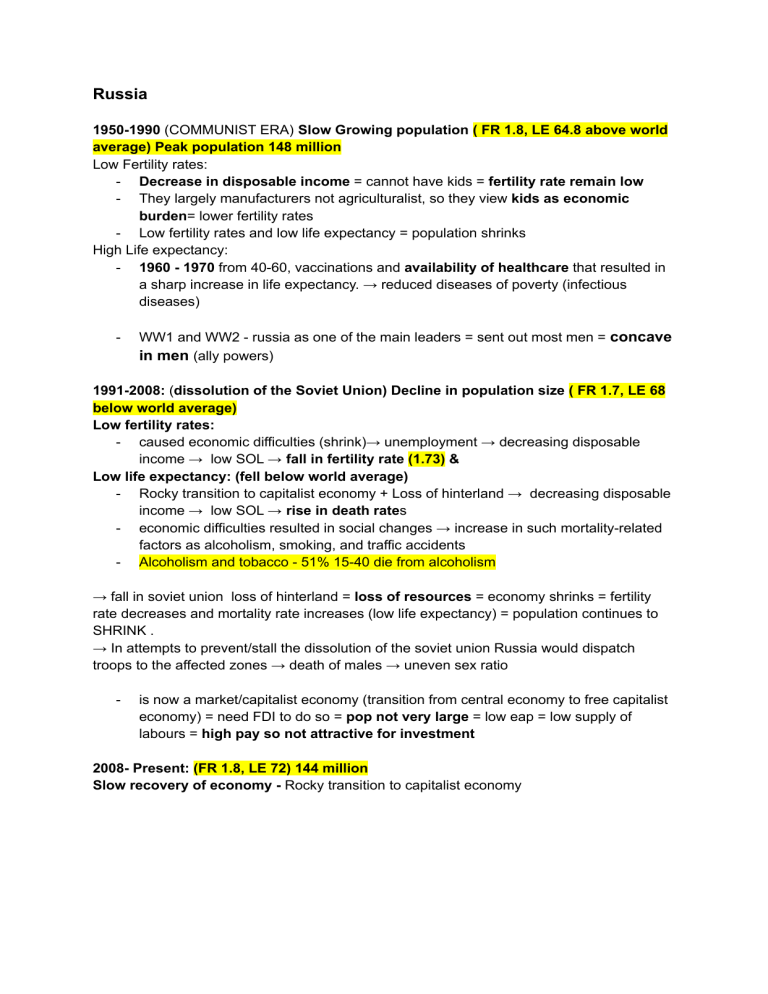
Russia 1950-1990 (COMMUNIST ERA) Slow Growing population ( FR 1.8, LE 64.8 above world average) Peak population 148 million Low Fertility rates: - Decrease in disposable income = cannot have kids = fertility rate remain low - They largely manufacturers not agriculturalist, so they view kids as economic burden= lower fertility rates - Low fertility rates and low life expectancy = population shrinks High Life expectancy: - 1960 - 1970 from 40-60, vaccinations and availability of healthcare that resulted in a sharp increase in life expectancy. → reduced diseases of poverty (infectious diseases) - WW1 and WW2 - russia as one of the main leaders = sent out most men = concave in men (ally powers) 1991-2008: (dissolution of the Soviet Union) Decline in population size ( FR 1.7, LE 68 below world average) Low fertility rates: - caused economic difficulties (shrink)→ unemployment → decreasing disposable income → low SOL → fall in fertility rate (1.73) & Low life expectancy: (fell below world average) - Rocky transition to capitalist economy + Loss of hinterland → decreasing disposable income → low SOL → rise in death rates - economic difficulties resulted in social changes → increase in such mortality-related factors as alcoholism, smoking, and traffic accidents - Alcoholism and tobacco - 51% 15-40 die from alcoholism → fall in soviet union loss of hinterland = loss of resources = economy shrinks = fertility rate decreases and mortality rate increases (low life expectancy) = population continues to SHRINK . → In attempts to prevent/stall the dissolution of the soviet union Russia would dispatch troops to the affected zones → death of males → uneven sex ratio - is now a market/capitalist economy (transition from central economy to free capitalist economy) = need FDI to do so = pop not very large = low eap = low supply of labours = high pay so not attractive for investment 2008- Present: (FR 1.8, LE 72) 144 million Slow recovery of economy - Rocky transition to capitalist economy Cambodia pre-genocide 1950-1974: Growth in population (6.9 FR, 40) - Civil war → competition of scarce resources (desperation) - High death rate → lack of health care + malnutrition - High infant mortality - Civil war → rise of pol pot 1975-1979: Khmer Rouge (5.6 FR, LE 14) - Sharp decrease in population - pol pot (khmer rouge) - Political instability - Citizens vs gov - Support opposition to overthrow current gov - Civil war arise due to competition for scarce resources eg food - refugee crisis -more than 25% displaced to rural areas (apart of regime) - Increase in mortality rates→ lack of healthcare and proper nutrition, survive off insufficient rations Dent in male population → fought in wars - Low fertility rate due to the environment / low disposable income (Vietnamese people invaded cambodia in the end of khmer rouge (to over throw pol pot) → Vietnam power over the cambodian military (seen as the saviour) 1979- Present: Fall of khmer rouge (life expectancy 70 years, 2.2 TFR 2022) - Baby boom - Suffer from the effects of the vietnam invasion - Population reach peaked of 3.8 TFR and started declining (2.2 TFR 2022) - 1994 10 mil - Lack of crops = 1 in 3 people suffer from malnutrition - Signed a treaty in 1994 = peaceful and stable environment = higher rates of birth - Facing demographic dividend (profits) = dividends shared among stakeholders (when fertility rates are dropping, so u don’t spend profits on children) - Young EAP attractive to FDIs and TNCS, creates jobs → increase disposable income → increase life expectancy and FR - Growing population - View children as economic burden → caldwell Wealth theory (no longer agrarian)
